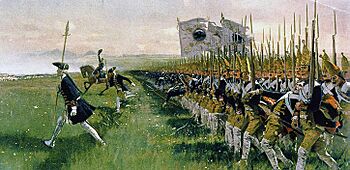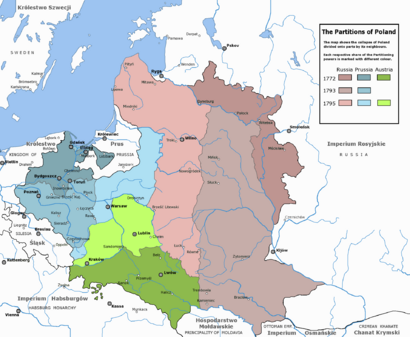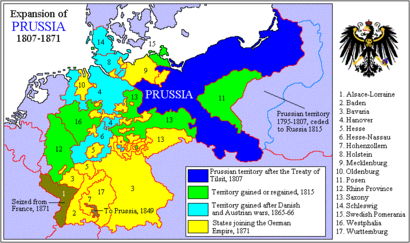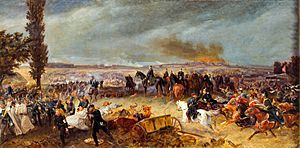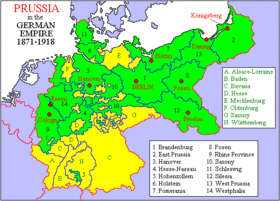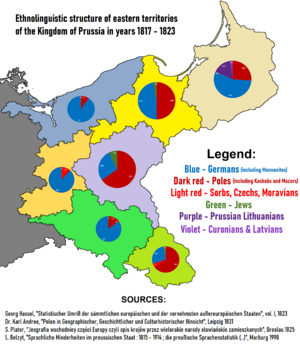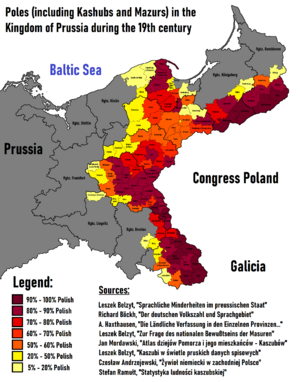Kingdom of Prussia facts for kids
Quick facts for kids
Kingdom of Prussia
Königreich Preußen (German)
|
|||||||||||||||||||||||||||||||||||||||||||||||||||||
|---|---|---|---|---|---|---|---|---|---|---|---|---|---|---|---|---|---|---|---|---|---|---|---|---|---|---|---|---|---|---|---|---|---|---|---|---|---|---|---|---|---|---|---|---|---|---|---|---|---|---|---|---|---|
| 1701–1918 | |||||||||||||||||||||||||||||||||||||||||||||||||||||
|
Anthem:
Borussia "Prussia" (1820–1830) Preußenlied "Song of Prussia" (1830–1840) Royal anthem: "Heil dir im Siegerkranz" "Hail to thee in the Victor's Crown" (1795–1918) |
|||||||||||||||||||||||||||||||||||||||||||||||||||||
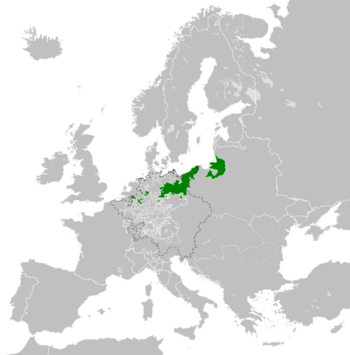 Within the Holy Roman Empire in 1714 Within the Holy Roman Empire in 1714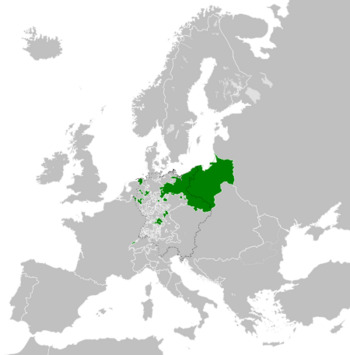 Within the Holy Roman Empire in 1797 Within the Holy Roman Empire in 1797 Within the German Confederation in 1815 Within the German Confederation in 1815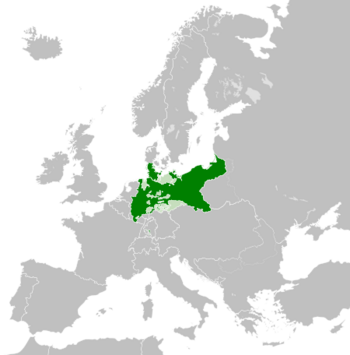 Within the North German Confederation in 1870 Within the North German Confederation in 1870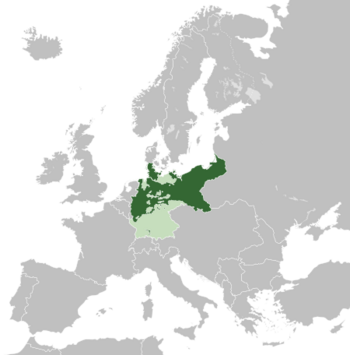 Within the German Empire in 1871 Within the German Empire in 1871 |
|||||||||||||||||||||||||||||||||||||||||||||||||||||
| Status | Kingdom | ||||||||||||||||||||||||||||||||||||||||||||||||||||
| Capital |
|
||||||||||||||||||||||||||||||||||||||||||||||||||||
| Common languages | Official: German Neo-Latin (until 1806) Polish (only in GD of Posen, 1815–1848) Minorities:
|
||||||||||||||||||||||||||||||||||||||||||||||||||||
| Religion | Statewide majority: Protestantism (Lutheran and Calvinist; Prussian United after 1817 (state religion)) Majority in some territories: Catholicism Other minorities: |
||||||||||||||||||||||||||||||||||||||||||||||||||||
| Demonym(s) | Prussian | ||||||||||||||||||||||||||||||||||||||||||||||||||||
| Government |
|
||||||||||||||||||||||||||||||||||||||||||||||||||||
| King | |||||||||||||||||||||||||||||||||||||||||||||||||||||
|
• 1701–1713 (first)
|
Frederick I | ||||||||||||||||||||||||||||||||||||||||||||||||||||
|
• 1888–1918 (last)
|
Wilhelm II | ||||||||||||||||||||||||||||||||||||||||||||||||||||
| Minister-President | |||||||||||||||||||||||||||||||||||||||||||||||||||||
|
• 1848 (first)
|
A. H. von Arnim-Boitzenburg | ||||||||||||||||||||||||||||||||||||||||||||||||||||
|
• 1918 (last)
|
Max von Baden | ||||||||||||||||||||||||||||||||||||||||||||||||||||
| Legislature | Landtag | ||||||||||||||||||||||||||||||||||||||||||||||||||||
| Herrenhaus | |||||||||||||||||||||||||||||||||||||||||||||||||||||
| Abgeordnetenhaus | |||||||||||||||||||||||||||||||||||||||||||||||||||||
| Historical era | |||||||||||||||||||||||||||||||||||||||||||||||||||||
|
• Coronation of Frederick I
|
18 January 1701 | ||||||||||||||||||||||||||||||||||||||||||||||||||||
| 6 August 1806 | |||||||||||||||||||||||||||||||||||||||||||||||||||||
|
• Formation of German Confederation
|
8 June 1815 | ||||||||||||||||||||||||||||||||||||||||||||||||||||
|
• Constitution adopted
|
5 December 1848 | ||||||||||||||||||||||||||||||||||||||||||||||||||||
|
• North German Confederation Treaty
|
18 August 1866 | ||||||||||||||||||||||||||||||||||||||||||||||||||||
|
• German Empire proclaimed
|
18 January 1871 | ||||||||||||||||||||||||||||||||||||||||||||||||||||
|
• Free State of Prussia proclaimed
|
9 November 1918 | ||||||||||||||||||||||||||||||||||||||||||||||||||||
|
• Abdication of Wilhelm II
|
28 November 1918 | ||||||||||||||||||||||||||||||||||||||||||||||||||||
| Area | |||||||||||||||||||||||||||||||||||||||||||||||||||||
| 1871 | 348,779 km2 (134,664 sq mi) | ||||||||||||||||||||||||||||||||||||||||||||||||||||
| Population | |||||||||||||||||||||||||||||||||||||||||||||||||||||
|
• 1756
|
4,500,000 | ||||||||||||||||||||||||||||||||||||||||||||||||||||
|
• 1816
|
10,349,031 | ||||||||||||||||||||||||||||||||||||||||||||||||||||
|
• 1871
|
24,689,000 | ||||||||||||||||||||||||||||||||||||||||||||||||||||
|
• 1910
|
40,169,219 | ||||||||||||||||||||||||||||||||||||||||||||||||||||
| Currency |
|
||||||||||||||||||||||||||||||||||||||||||||||||||||
|
|||||||||||||||||||||||||||||||||||||||||||||||||||||
| Today part of | Germany Poland Russia |
||||||||||||||||||||||||||||||||||||||||||||||||||||
|
|||||||||||||||||||||||||||||||||||||||||||||||||||||
The Kingdom of Prussia (German: Königreich Preußen) was a powerful German state that existed from 1701 to 1918. Even though it was named after the region of Prussia, its main base was in Brandenburg. The capital city was Berlin.
Prussia played a huge role in uniting Germany in 1866. It became the most important state in the German Empire until it ended in 1918. The kings of Prussia belonged to the House of Hohenzollern.
Before it became a kingdom, Brandenburg-Prussia grew into a strong military power. This happened under Frederick William, Elector of Brandenburg, who was known as "The Great Elector." As a kingdom, Prussia continued to gain power, especially during the rule of Frederick II "the Great".
Frederick the Great helped start the Seven Years' War (1756–1763). He fought against powerful countries like Austria, Russia, France, and Sweden. Prussia's strong army helped it win battles and become a major European power. This also made Prussia the most important German state.
Prussia tried to unite all the German states under its rule. A big question was whether Austria should be part of this unified Germany. After the Napoleonic Wars, the German Confederation was formed. This led to the German revolutions of 1848–1849, where people tried to unite Germany with their own constitution. But these attempts failed. The German Confederation broke apart in 1866 after the Austro-Prussian War between its two strongest members.
After this, Prussia led the creation of the North German Confederation in 1866. This group became the unified German Empire in 1871. The North German Confederation was first seen as a military alliance. But many of its laws were later used in the German Empire. The German Empire successfully united all German states, except Austria and Switzerland. This happened because Napoleon III was defeated in the Franco-Prussian War of 1870–1871. The war brought all German states together against a common enemy. The victory created a strong feeling of nationalism, which changed many people's minds about unification.
The German Revolution of 1918–1919 changed the Kingdom of Prussia into the Free State of Prussia. The entire state of Prussia was later ended in 1947.
Contents
History of Prussia
How Prussia Became a Kingdom
The Hohenzollerns family became the rulers of Margraviate of Brandenburg in 1518. In 1618, they also inherited the Duchy of Prussia. This duchy had been ruled by a younger branch of the Hohenzollern family since 1511.
In 1525, Albrecht of Brandenburg changed his territory from a religious state to a duchy. It was ruled together with Brandenburg, and this was called "Brandenburg-Prussia". A full union was not possible at first. Brandenburg was part of the Holy Roman Empire, but the Duchy of Prussia was a fief (land held in exchange for loyalty) of Poland.
In 1657, the Hohenzollerns gained full control over the Prussian duchy. This happened through the Labiau and Wehlau-Bromberg agreements.
In 1700, Frederick III, the son of the Great Elector, was allowed to make Prussia a kingdom. This was in exchange for an alliance against France in the War of the Spanish Succession. Frederick crowned himself "King in Prussia" as Frederick I on January 18, 1701.
Legally, there could only be kingdoms in the Holy Roman Empire like Bohemia and Italy. But Frederick argued that Prussia was never part of the empire. Since the Hohenzollerns fully controlled it, he could make it a kingdom. Emperor Leopold I agreed because he wanted Frederick's help in the upcoming war.
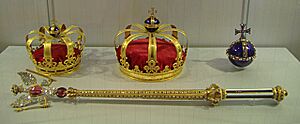
The title "King in Prussia" was used to show that the Hohenzollerns were only kings in their old duchy. In Brandenburg and other parts of their lands within the Empire, they were still just electors. But by this time, the emperor's power was mostly just on paper. Rulers of other territories in the empire acted like they were in charge of their own countries.
It wasn't until 1772 that the title "King of Prussia" was used. This happened after they gained Royal Prussia in the First Partition of Poland.
Early Challenges: Plague and War (1701–1721)
The Kingdom of Prussia was still recovering from the Thirty Years' War. It didn't have many natural resources. Its land was spread out, from the Baltic Sea to Brandenburg. There were also separate areas in the Rhineland.
In 1708, about one-third of the people in East Prussia died during a plague outbreak. The plague reached Prenzlau in 1710 but stopped before reaching Berlin.
The Great Northern War (1700–1721) was Prussia's first big conflict. It involved Russia against Sweden. In 1715, Prussia joined the fight. They joined to protect themselves and to gain land in Pomerania. Prussia only fought in one battle, the Battle of Stresow. The war ended the Swedish Empire's power. It also made Prussia and Russia new strong powers in Europe.
The Great Elector had brought the Junkers (landowners) into the government and military. This gave them a reason to support the Prussian Army and compulsory education. King Frederick William I started a system where all men had to join the army in 1717.
The Silesian Wars (1740–1762)
In 1740, Frederick II (Frederick the Great) became king. He used an old treaty as an excuse to invade Silesia. This started the War of the Austrian Succession. Frederick quickly took Silesia. He offered to protect Queen Maria Theresa if she gave him the province. She refused. But Austria was fighting other enemies. So, Frederick eventually gained Silesia in the Treaty of Berlin in 1742.
Austria tried to get Silesia back. In 1744, Frederick invaded again. He wanted to prevent Austria from getting revenge. He also tried to claim the Kingdom of Bohemia. He failed, but other countries pressured Austria. This led to the 1748 Treaty of Aix-la-Chapelle. This treaty brought peace and left Prussia with most of Silesia.
Austria was upset about losing Silesia. It formed alliances with France and Russia. This was called the "Diplomatic Revolution." Prussia, on the other hand, became allies with Great Britain.
In 1756, Frederick invaded Saxony and Bohemia. This started the Third Silesian War and the Seven Years' War. This war was very difficult for the Prussian Army. Frederick had to fight Austria, Russia, France, and Sweden at the same time. His only main allies were Hanover and Great Britain.
The situation became very bad for Prussia. But in 1762, Empress Elizabeth of Russia died. Her successor, Peter III, was friendly towards Prussia. This eased the pressure on Prussia's eastern border. Sweden also left the war.
Prussia defeated the Austrian army at the Battle of Burkersdorf. With Britain's success against France, Prussia was able to force a peace treaty. This confirmed Prussia's important role among German states. It also made Prussia a major European power. After this, Frederick became a more peaceful ruler.
Prussia also gained other lands in the 1700s. These included County of East Frisia (1744), Principality of Bayreuth (1791), and Principality of Ansbach (1791).
Dividing Poland (1772, 1793, 1795)
To the east and south of Prussia, the Polish–Lithuanian Commonwealth became weaker in the 1700s. Frederick was worried about Russia's growing influence in Poland. He helped start the first Partitions of Poland in 1772. Russia, Prussia, and Austria divided parts of Poland to keep a balance of power.
The Kingdom of Prussia took most of the Polish province of Royal Prussia. This included Warmia. This allowed Frederick to finally use the title King of Prussia. The new land became the Province of West Prussia.
After Frederick died in 1786, his nephew Fredrick William II continued dividing Poland. In 1793, Prussia gained a large part of western Poland. This included Thorn (Toruń) and Danzig (Gdańsk). These areas became part of West Prussia. The rest became the province of South Prussia.
In 1795, the Polish-Lithuanian Commonwealth ceased to exist. A large area, including Warsaw, became part of Prussia. Most of these new lands became the province of New East Prussia. South Prussia gained the area south of the Vistula, Narew, and Bug rivers, including Warsaw. A small area south of South Prussia became New Silesia.
These divisions happened before nationalism became strong in Europe. Many people in Poland saw Prussia as just another land owned by the Hohenzollern family. They were more worried about religious freedom than national identity. But later, efforts to make Poles more German changed this view. This led to Polish resistance against Prussian rule.
Prussia and the Napoleonic Wars (1801–1815)
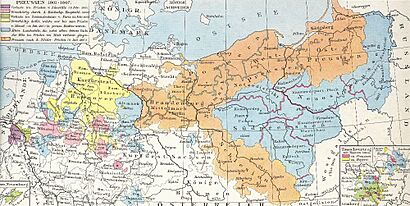
After the French Revolution, Prussia went to war with France. Prussia was defeated, and the Treaty of Basel (1795) ended the war. In this treaty, Prussia agreed to keep the Holy Roman Empire neutral in its northern territories.
In 1806, Napoleon Bonaparte encouraged Prussia to take over Hanover. Prussian soldiers invaded and Hanover surrendered easily. On August 6, 1806, the Holy Roman Empire was dissolved because of Napoleon's victories. The title of Elector of Brandenburg became meaningless. King Frederick William III was now truly the ruler of all Hohenzollern lands.

But when Prussia turned against France, it was defeated in the Battle of Jena–Auerstedt in 1806. Frederick William III had to flee. After the Treaties of Tilsit in 1807, Prussia lost about half of its land. This included land gained from the Polish partitions. French troops occupied the rest of the kingdom. The king had to become an ally of France.
The Prussian reforms were a response to this defeat. They were a series of changes to Prussia's government, society, and economy. These are sometimes called the Stein-Hardenberg Reforms after their main leaders.
After Napoleon's defeat in Russia in 1812, Prussia left its alliance with France. It joined the "Wars of Liberation" against French occupation. Prussian troops helped greatly in the Battle of Waterloo in 1815. This led to the final victory over Napoleon.
Prussia After Napoleon (1815)
Prussia was rewarded for its role in defeating France at the Congress of Vienna. It got back most of its land from before 1806. Some parts of Poland it had gained were lost to Russia. But Prussia gained new land, including parts of Saxony, Westphalia, and the Rhineland. Prussia now stretched from the Niemen River in the east to the Elbe River in the west. It also had separate territories west of the Elbe. This made Prussia the only major power with mostly German-speaking people.
With these new lands, the kingdom was divided into 10 provinces. Most of the kingdom became part of the new German Confederation. This was a group of 39 independent states, including Austria. It replaced the old Holy Roman Empire.
Frederick William III made many changes to Prussia's government. He organized the government into ministries, which lasted for a hundred years.
In terms of religion, King Frederick William III, who was Calvinist, wanted to unite the Lutheran and Reformed Churches. In 1817, they formed the Evangelical Church in Prussia. However, this led to disagreements and a permanent split among Lutherans by 1830.
In 1850, the Principalities of Hohenzollern-Sigmaringen and Hohenzollern-Hechingen joined Prussia. They later became the Province of Hohenzollern.
German Unification Wars (1848–1871)
After the Congress of Vienna, there was a debate in the German Confederation. Should Germany become one nation, or stay as many small states? The main question was whether Prussia or the Austrian Empire should lead a united Germany. Those who supported Prussia argued that Austria had too many non-German interests. They believed Prussia, being the most powerful German-speaking state, was best suited to lead.
The creation of the German Customs Union (Zollverein) in 1834, which excluded Austria, increased Prussia's influence. In 1849, the Frankfurt Parliament offered King Frederick William IV of Prussia the crown of a united Germany. Frederick William refused. He believed that revolutionary groups could not give royal titles. He also worried that a German Empire would end Prussia's independence.
In 1848, Denmark's actions towards Schleswig and Holstein led to the First War of Schleswig. Denmark won this war.
Frederick William issued Prussia's first constitution in 1848. He changed it in the Constitution of 1850. These documents created a two-chamber parliament called the Landtag. The lower house was elected by men over 25. But votes were weighted based on taxes paid, which favored wealthier people. The upper house was chosen by the king. The king kept full power, and ministers answered only to him. This meant that the landowners, called Junkers, kept their power. The constitution did include liberal ideas like jury courts and freedom of religion, speech, and press.
In 1857, Frederick William had a stroke. His younger brother, Prince William, became the regent. William followed a more moderate path. When Frederick William IV died in 1861, William became King William I.
Soon after becoming king, William had a disagreement with parliament about the size of the army. Parliament, mostly liberals, didn't want to approve the budget for more soldiers. William considered giving up his throne. But he decided to appoint Otto von Bismarck as prime minister in 1862.
Bismarck was known as a strong conservative. But he wanted to find a way to unite Germany. He believed that conservative forces should lead this effort. He also thought that middle-class liberals wanted a united Germany more than they wanted to change society. So, he led Prussia through three wars to achieve this goal.
The first war was the Second War of Schleswig in 1864. Prussia, with Austria's help, defeated Denmark. Denmark gave up Schleswig and Holstein to Prussia and Austria.
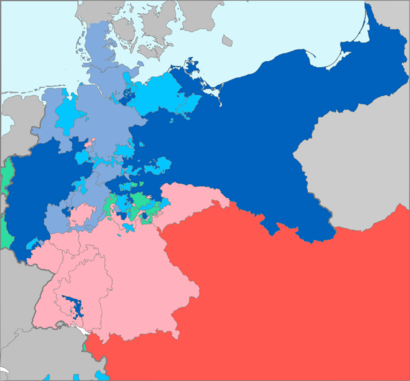
The way Schleswig and Holstein were managed led to the Austro-Prussian War in 1866. Prussia, allied with Italy and some northern German states, declared war on Austria. Prussia won easily. It annexed four smaller German states: Hanover, Hesse, Nassau, and Frankfurt. Prussia also took Schleswig and Holstein. It also effectively took over Saxe-Lauenburg. King William wanted to take land from Austria and Saxony. But Bismarck convinced him not to. Bismarck believed Austria could be a useful ally later. With these new lands, Prussia's territories in the Rhineland and Westphalia finally connected to the rest of the kingdom. Prussia now stretched across the northern two-thirds of Germany.
Bismarck used this victory to end the budget dispute with parliament. He asked for approval for governing without a legal budget. He correctly guessed that this would divide his liberal opponents. Most liberals supported the bill, hoping for more freedom in the future.
The German Confederation was dissolved. In its place, Prussia convinced 21 northern German states to form the North German Confederation in 1866. Prussia became the most powerful state in this new group. It had four-fifths of the land and population. Its control was made stronger by a constitution written by Bismarck. The Prussian ruler was the president of this Confederation. He was helped by a chancellor who answered only to him. There was also a parliament with two houses. The lower house was elected by all men. The upper house was chosen by the state governments. Prussia had 17 out of 43 votes in the upper house, giving it strong control.
The southern German states were forced to make military alliances with Prussia. Bismarck's plan for a smaller, unified Germany (Kleindeutschland) was almost complete.
The final step was the Franco-Prussian War (1870–1871). Bismarck tricked Emperor Napoleon III of France into declaring war on Prussia. The German states, except Austria, united and quickly defeated France. Napoleon III was even captured. On January 18, 1871, the German Empire was proclaimed at the Versailles outside Paris. King William became the first emperor (Kaiser) of a united Germany. The titles of German Emperor and King of Prussia were held by the same person until the monarchy ended.
Prussia's Peak and End (1871–1918)
Bismarck's new German Empire was the strongest state in Europe. Prussia's power over the new empire was almost complete. It had two-thirds of the empire's land and three-fifths of its people. The emperor's crown was passed down through the Hohenzollern family. Prussia also had many votes in the Bundesrat (Federal Council). The Imperial German Army was mostly an enlarged Prussian army. The Constitution of the German Empire was based on the North German Confederation's constitution.
However, there were problems for the future. The empire allowed all men over 25 to vote. But Prussia kept its three-class voting system. In this system, votes were weighted by taxes paid. This meant that the emperor and prime minister often had to deal with two different voting systems.
When the empire was created, both Prussia and Germany were mostly rural. Within 20 years, most people lived in cities. But voting districts were never changed to reflect this. This meant that rural areas had too much power in voting from the 1890s onwards.
Bismarck knew that other European countries were worried about his powerful new Germany. He worked to keep peace, for example, through the Congress of Berlin. Germany also improved its strong relationship with Britain. This bond was strengthened when Crown Prince Frederick William of Prussia married Victoria, Princess Royal in 1858.
William I died in 1888. His son, Frederick III, became emperor. Frederick wanted to make Prussia and the empire more liberal and democratic, like Britain. But Frederick was already sick with throat cancer. He died after only 99 days on the throne. His 29-year-old son, William II, became the next emperor. As a boy, William had resisted his parents' liberal ideas. He had become very "Prussianized" under Bismarck's teaching.
The new Kaiser William quickly made relations worse with the British and Russian royal families. He became their rival and enemy. Before and during World War I (1914–1918), Prussia provided many soldiers and sailors for the German military. Prussian Junkers held most of the high ranks. Parts of the Eastern Front were fought on Prussian land. Prussia, like all of Germany, faced more and more problems with revolutionaries during the war. The Great War ended on November 11, 1918.
Uprisings in Berlin and other cities started the German Revolution of 1918–19. By late 1918, the Prussian parliament was controlled by the Social Democratic Party. William knew he had lost his imperial crown. But he hoped to keep his Prussian crown. He thought that as ruler of two-thirds of Germany, he could still be important. However, he found this was not possible under the imperial constitution. He had also lost the support of the military. William's abdication as both king of Prussia and German emperor was announced on November 9, 1918. He went into exile in the Netherlands the next day. With revolts, strikes, and street fighting in Berlin, the Prussian government declared a state of emergency. They asked for military help. The revolutionary period lasted until August 1919. This is when a republic, later known as the Weimar Republic, was established.
Prussia became the Free State of Prussia within the Weimar Republic. It got a new republican constitution in 1920. The state of Prussia was officially ended in 1947.
Prussian Government and Politics
How Prussia Was Governed
Prussia was an absolute monarchy (where the king had all the power) until the German revolutions of 1848–1849. After these revolutions, Prussia became a constitutional monarchy. This meant the king's power was limited by a constitution. Adolf Heinrich von Arnim-Boitzenburg became Prussia's first Minister President.
Following Prussia's first constitution, a two-house parliament called the Landtag was created.
- The lower house, called the Prussian House of Representatives, was elected by men over 25. However, the Prussian three-class franchise system meant that votes were weighted based on how much tax people paid. This gave more power to wealthier people.
- The upper house, later called the Prussian House of Lords, was chosen by the king.
The king kept full executive power. His ministers were only responsible to him. This meant that the landowning class, the Prussian Junkers, kept their strong influence. The Prussian Secret Police, created after the 1848 revolutions, helped the conservative government.
Prussian Constitutions
Prussia had two main constitutions during its time as a kingdom: one from 1848 and one from 1850.
The 1848 constitution was given by King Frederick William IV. This happened because people demanded changes during the German revolutions of 1848–1849. Elections were held for a Prussian National Assembly. All men aged 25 and older could vote. The King and his ministers presented a draft constitution. It allowed the king to keep many of his old powers. The Assembly responded with their own ideas, including more basic rights and a people's guard. On December 5, 1848, the King put the 1848 Constitution into effect by himself. It included many liberal ideas, like a two-chamber parliament, jury courts, and some limits on the king's power. It also guaranteed freedoms like speech, press, and religion.
Even with these liberal parts, Prussia was not a democratic state. The king could stop laws he didn't like. The military was very independent. All adult men could vote, but the Prussian three-class franchise system greatly reduced the political power of the middle and lower classes.
The 1850 Constitution of Prussia was an updated version of the 1848 one. This time, the new Prussian Parliament, the King, and his ministers worked together. The changes were mostly small. The king remained very powerful over the government. Parliament had no control over the military. But the liberal ideas from the 1848 Constitution mostly stayed in place.
The 1850 Constitution, with some changes over time, was the main law of Prussia until the German Empire ended in 1918.
Religion in Prussia
The Prussian Constitution of 1850 allowed people to believe what they wanted. It also allowed them to worship openly or privately. It said that churches and other religious groups should manage their own affairs, separate from the state. It also stated that children should be taught their religion by people of their own faith.
A census from the 1830s showed the main religions. Out of every million people, about 609,427 were Protestants, 376,177 were Catholics, and 13,348 were Jewish. There were also smaller groups like Mennonites, Greek Orthodox, and Muslims. At this time, Prussia had about 14 million people.
Even though Protestants (Lutherans and Calvinists) were the majority, millions of Catholics lived in the western parts and in Poland. There were many Catholic people in the Rhineland and Westphalia. Also, areas like West Prussia, Warmia, Silesia, and Posen had mostly Catholic Polish-speaking people. East Prussia's southern region, Masuria, was mostly made up of Germanized Protestant Masurs.
People of Prussia
Besides ethnic Germans, Prussia was home to many other groups. These included Poles (like Kashubs and Mazurs), Prussian Lithuanians, Sorbs, Czechs, Moravians, Danes, Jews, Frisians, Dutch, Walloons, Russians, French, Italians, and Hungarians.
Divisions of Prussia

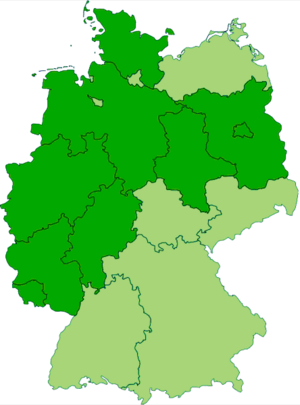
The main parts of the Kingdom of Prussia were Margraviate of Brandenburg and the Duchy of Prussia. These two together formed Brandenburg-Prussia. Prussia had also held a part of Pomerania since 1653. When it gained more land from Sweden in 1720 and 1815, this area became the Province of Pomerania. After Prussia won the Silesian Wars, the Province of Silesia was formed in 1740.
After the First Partition of Poland in 1772, the newly taken lands of Royal Prussia and Warmia became the Province of West Prussia. The Duchy of Prussia became the Province of East Prussia. Other annexed lands became the Netze District. After the second and third partitions of Poland (1793–1795), new Prussian lands became the provinces of New Silesia, South Prussia, and New East Prussia.
After Prussia gained many western lands from the Vienna Congress, it was divided into ten provinces. Each province was then split into smaller administrative regions called Regierungsbezirke. The provinces were:
- Province of Brandenburg
- Province of East Prussia (outside of German Confederation)
- Province of Jülich-Cleves-Berg
- Grand Duchy of the Lower Rhine
- Province of Pomerania
- Grand Duchy of Posen (autonomous, outside of German Confederation)
- Province of Saxony
- Province of Silesia
- Province of West Prussia (outside of German Confederation)
- Province of Westphalia
In 1822, the provinces of Jülich-Cleves-Berg and the Lower Rhine combined to form the Rhine Province. In 1829, East and West Prussia merged to become the Province of Prussia. But they were separated again in 1878. The principalities of Hohenzollern-Sigmaringen and Hohenzollern-Hechingen joined Prussia in 1850 to form the Province of Hohenzollern.
After Prussia won the Austro-Prussian War in 1866, the new lands it gained were organized into three more provinces:
- Province of Hanover
- Province of Hesse-Nassau
- Province of Schleswig-Holstein
Images for kids
See also
 In Spanish: Reino de Prusia para niños
In Spanish: Reino de Prusia para niños





